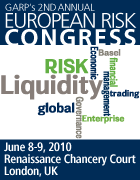Following quickly on the heels of the executive risk manager panel was a discussion on "Enterprise Risk Management: Integrating Risk and Performance Management - A Multidisciplinary View on Risk."
And might I say, I am amazed at the size of the crowd still in attendance. Hundreds! Snowstorm? What snowstorm? Bah!
Readers will forgive me if I am short on names and titles appearing on this panel. I showed up a few minutes late and there were some switches made. I caught the names of a few of them, but only the first name and company of the last. Appearing, then: Kevin Buehler, Director, McKinsey (and moderator); Jonathan Stein, VP and CRO, Hess Corporation; Kanwardeep Ahluwalia, Head of Financial Risk Management, Swiss Re; Glenn Labhart, President of Labhart Risk Advisors, and Rodney, from Vanguard.
Here are some of the highlights:
Buehler: How does risk management work in your company?
Ahluwalia: Swiss Re uses a three signature process to increase accountability and ensure that multiple parties are involved in decision making processes.
Stein: At Hess, the key is to be transparent. One needs to be consistent too, and this is accomplished with formal, standardized processes (be it in determining metrics, governance, etc).
Labhart: Mr. Labhart looks at the energy value chain as a model - production, processing, and storage are elements along this chain that must be considered. The point is to identify and define what physical risks you have to better understand exposure, and the best way to hedge/mitigate the risks.
Buehler: On risk and return trade-offs: How do you make sure people take it seriously when executives are most interested in just looking at returns?
Stein: Change is coming through increased transparency and how to promulgate the risk structure. Qualitative and quantitative methods are being combined, the latter providing a basis for discussion for the former.
Strategists make assumptions five to ten years out, whereas risk managers get bogged down in, for example, correlations. Risk managers need to do better in making more strategic assumptions.
Labhart: Business units and risk units need to communicate more effectively so there is one view everyone shares, and there are no misunderstandings.
Question from audience: During annual budget and strategic reviews, is enterprise risk management considered?
Roger: One problem to consider is how to collate all the information coming from below to convey to executives.
Labhart: The reviews are the best time to capitalize on the relationships created throughout the year. Leverage these connections so that all voices can be heard and understood for moving forward.
Question from the audience: How long can CEOs hold out and listen to risk managers when the sky seems to be so blue? When things look golden in the market, for how long can the CEO take the advice of risk managers and keep his foot off the pedal?
Ahluwalia: It's a very good question. Even in good times, though, what are the signals for bad turns? Bringing this to the fore is difficult too. Personalities of CEOs differ, but the imporant thing is to make decisions. Good or bad, decision making provides practice and allows for the ability to self-correct when the time comes.
Stein: How do you turn risk analysis into action? When risk appetites are too great, how do you implement measures (triggers) that mitigate doomsday events?
Rodney: Guiding principles, values, ethics keep you on the right path. For example, when internet stocks were soaring and looked great, Vanguard did not bite because they did not fit into our core focus. We avoided them and did not get burned when the bubble burst.
And that... my friends... is it for my reporting from GARP's 11th annual convention! I hope you all enjoyed my notes, and I look forward to seeing you at upcoming events.
Until then, let it snow...
Wednesday, February 10, 2010
Subscribe to:
Post Comments (Atom)






0 comments:
Post a Comment